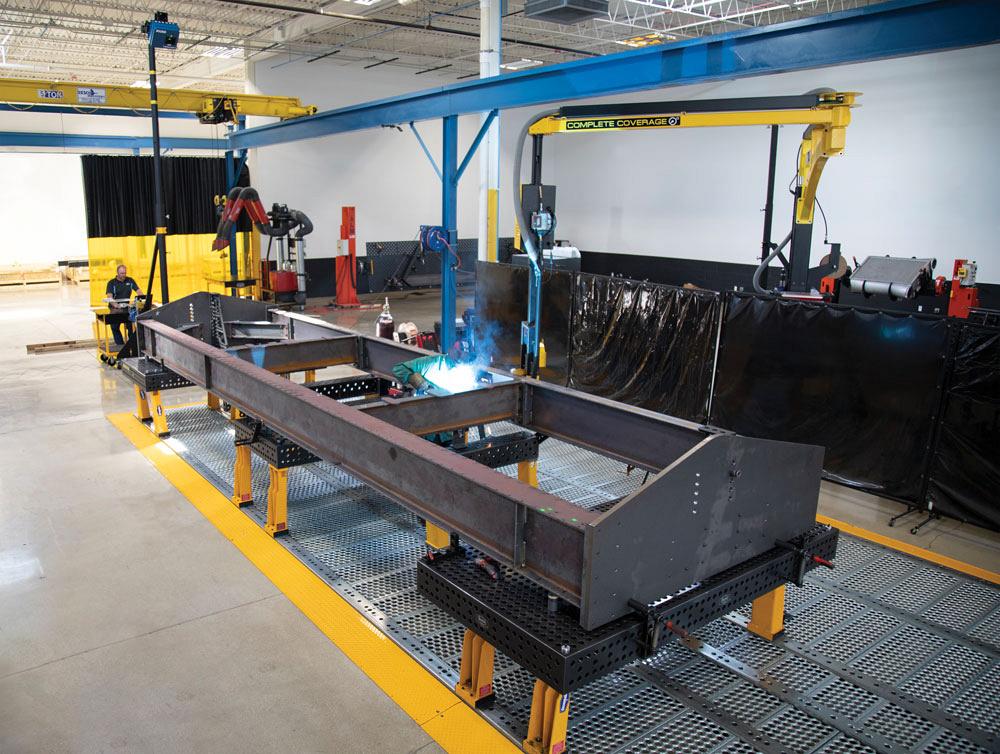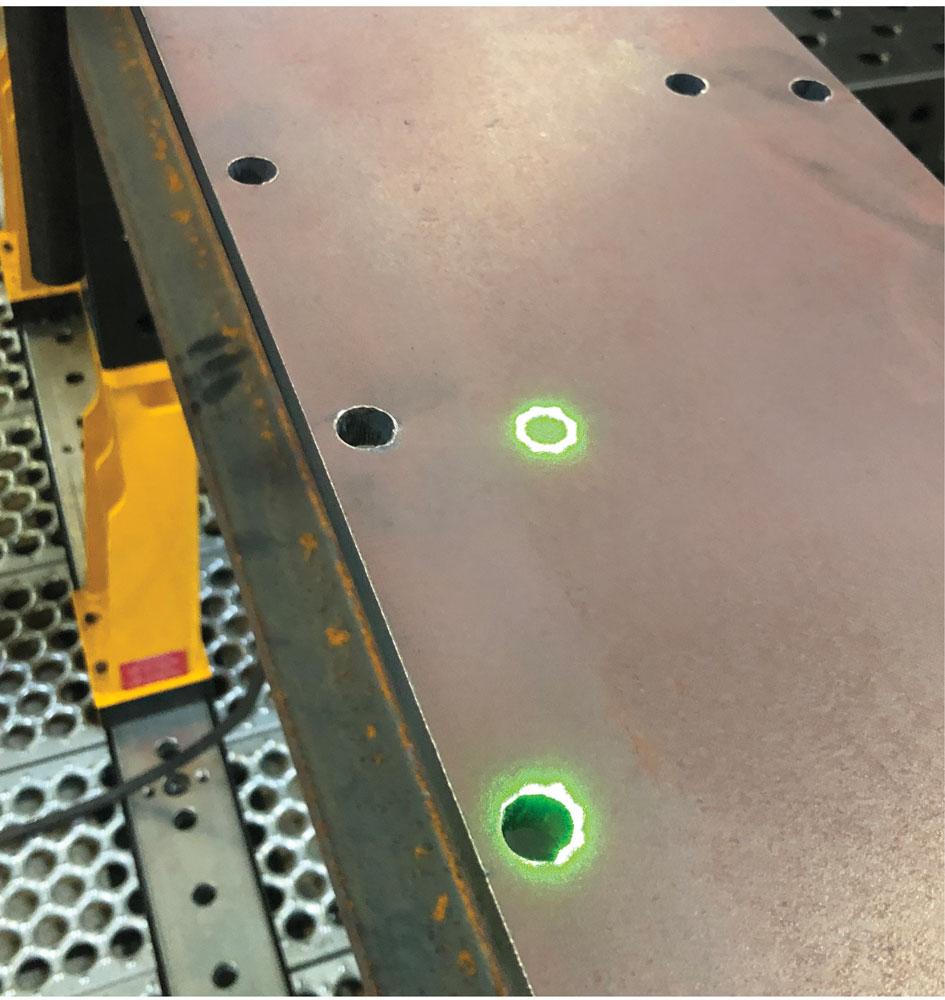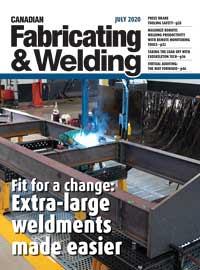Editor
- FMA
- The Fabricator
- FABTECH
- Canadian Metalworking
Fit for a change: Extra-large weldments made easier
How new tech is streamlining the big-job fixturing process
- By Rob Colman
- July 15, 2020
- Article
- Welding

Lasers mounted above the fixture, a modular rail system, and a welding boom make extra-large weldments much easier to handle.
Extra-large part weldment fixturing has long been considered more of a headache than a benefit for a variety of reasons. Top on the list of challenges are the difficulties of fixture installation, part and fixturing management, and part install and removal. But new approaches to the fixturing process itself, as well as the addition of time-saving peripheral tools, are easing these pains. Using the right tools can speed up production while improving the comfort and safety of operators.
Modular Floor Rail Systems
Todd Bennett, engineer at Bluco, Naperville, Ill., said step one for shops considering fixturing for extra-large weldments is to reach out for help.
“We’re able to come up with solutions that are based on designing fixturing for thousands of different parts,” he said. “The earlier you reach out, the better, because we can apply all that knowledge and save the time it takes to work through the options.”
For Bennett, it’s important that fabricators think beyond fixturing as a table.
“Everyone’s first thought is to go with a table, because that was the original approach to modular fixturing. So a lot of customers assume that’s what they’ll be purchasing for their job,” he said. “But there are other approaches that have been developed in the 30-year history of the company that make more sense for certain projects than a large table.”
For extra-large weldments, for instance, Bennett suggests fabricators consider a modular floor rail system. A floor rail system is built by attaching two parallel rails to the floor, levelling them, and then putting the necessary fixturing components on the rails. This may include a series of fixturing tables, but could also include U-forms. Having modular fixtures on the rails allows for a variety of setups.
“The rail system allows us to put the point of reference and flatness right on the floor, which in turn helps support heavier weights,” said Bennett. “A big fixture can also mean a heavier fixture. With the rails and our floor plates, we can get the weight transferred right down to the floor. The rails also mean that each table and U-form along that length will be parallel and square with each other.”
The rail system also creates flexibility in and around the fixtured part. For instance, with the right selection of components, it’s possible to design a fixture that gives a welder interior access to the part.
“With a traditional table or plate fixture, you’re tied 3 ft. off the floor where your working surface is,” said Bennett. “You have to walk all the way around the fixture to complete the job. For instance, if you’re working on a weldment that’s 10 ft. wide and 50 ft. long, with a regular table a welder might have to reach in 5 ft. from either side to do a weld, which is difficult. Or climb up onto the table, which isn’t safe without steps and a safety railing. With rails and U-forms, we can create an aisle through the middle of that assembly that allows the welder to work on both sides of the assembly more easily.”

Laser projection can be used to make sure piece parts are placed correctly. Here, notice the laser marking at the top doesn’t line up with a hole on the part.
Bennett also pointed out that a modular system like this is easier to transport to and install in a shop. Wheels on the base of the tables and U-forms can make changeover easier and eliminate the need for an overhead crane.
Laser Projection
Modular fixturing has been evolving over the years, and new technologies have been integrated. The result is an expanded range of modular capabilities.
“Today there’s no shape we can’t fixture. And the innovations that are out there have allowed us to shave a significant amount of time off the process,” said Bennett. Lasers are just one of these innovations.
Consider how laser projection might help in fixturing an extra-long part. If you have a 70-ft.-long, 16-ft.-wide, 14-ft.-tall assembly, a modular fixture is going to have a lot of holes. There are also going to be a lot of welds on that part. Keeping track of everything that needs to be placed and welded is inevitably going to be a challenge. But laser projection technology is now available to assist with all of this.
These laser projectors can sit high above the part and, as is suggested by the name, project onto the part what you ask it to.
“Bluco has partnered with FARO Technologies, and we use their BuildIT construction software to help make sure each modular component is placed exactly where it’s supposed to be,” said Bennett. “The software turns the CAD fixture into a pattern that the laser then projects so you can see an outline of where components go, which saves the operator counting holes on a fixturing table or measuring out precisely where the fixture should be placed,” said Bennett. “That’s the first benefit – helping you set up your part. The second benefit it offers is helping you to place components by projecting the actual piece parts that are getting inlaid in the fixture. It can then serve as an inspection tool, ensuring all parts are placed correctly.
“The third benefit is that it can walk a welder through a weld sequence,” he continued. “Basically, the welder just follows the light around the weldment, following the most efficient weld path throughout. This goes back to contacting us early in the problem-solving process. We can help you figure out where innovations like lasers can make your fixturing solution better.”
Welding Booms
The use of welding booms also can simplify and speed up extra-large weldment production.

Here, the part has been flipped and laser markings now line up to the holes, verifying correct placement.
“We use WeldPro booms by Andersen Industries,” said Bennett. “They developed their booms out of necessity. They were struggling to weld around 30 up to 50-ft.- long trailers. It’s simply time-consuming and, to some extent, a safety hazard having your welding equipment on the floor doing a big job like this. Using a boom also means that you can easily get your whip and feeder out over the centre of the weldment and easily access all the weld points. It works well in conjunction with the modular system.”
These weld booms often have an integrated computer screen that can display drawings, fixture setups, and weld procedures. Features like these help welders get things done faster and with less room for error.
Fixturing large weldments like crane booms, train cars, and semi-trailers will never be a simple process, but the right approach can be economical and efficiently managed.
Editor Robert Colman can be reached at rcolman@canadianfabweld.com.
Bluco, www.bluco.com
About the Author

Rob Colman
1154 Warden Avenue
Toronto, M1R 0A1 Canada
905-235-0471
Robert Colman has worked as a writer and editor for more than 25 years, covering the needs of a variety of trades. He has been dedicated to the metalworking industry for the past 13 years, serving as editor for Metalworking Production & Purchasing (MP&P) and, since January 2016, the editor of Canadian Fabricating & Welding. He graduated with a B.A. degree from McGill University and a Master’s degree from UBC.
subscribe now


Keep up to date with the latest news, events, and technology for all things metal from our pair of monthly magazines written specifically for Canadian manufacturers!
Start Your Free Subscription- Trending Articles
Aluminum MIG welding wire upgraded with a proprietary and patented surface treatment technology

CWB Group launches full-cycle assessment and training program

Achieving success with mechanized plasma cutting

Hypertherm Associates partners with Rapyuta Robotics

Brushless copper tubing cutter adjusts to ODs up to 2-1/8 in.

- Industry Events
MME Winnipeg
- April 30, 2024
- Winnipeg, ON Canada
CTMA Economic Uncertainty: Helping You Navigate Windsor Seminar
- April 30, 2024
- Windsor, ON Canada
CTMA Economic Uncertainty: Helping You Navigate Kitchener Seminar
- May 2, 2024
- Kitchener, ON Canada
Automate 2024
- May 6 - 9, 2024
- Chicago, IL
ANCA Open House
- May 7 - 8, 2024
- Wixom, MI
















